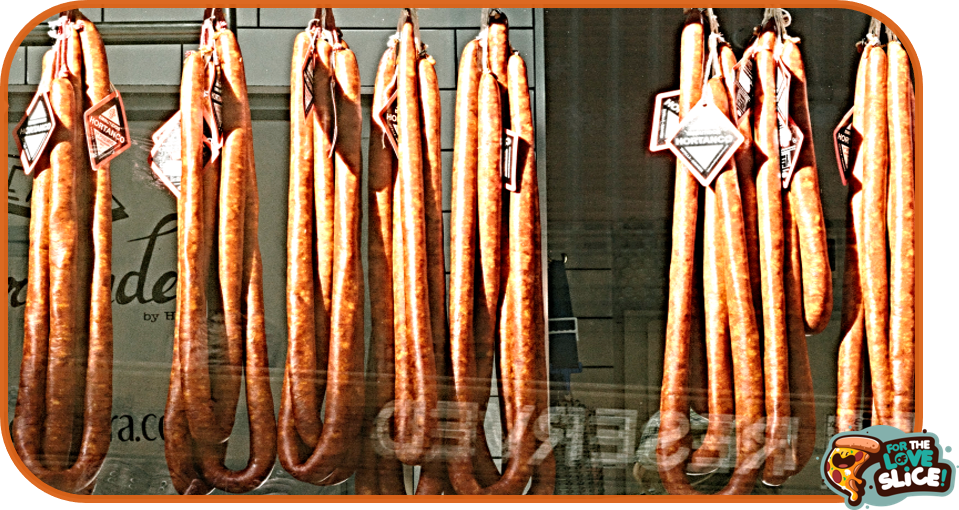
In the realm of cured sausages, two names often stand out: salami and pepperoni. These meat products, with their unique flavor profiles and distinct textures, have become staples in many food items worldwide. But what sets them apart? This article aims to delve into the main differences between these two types of meat, from their Italian origins to their role in modern cuisine.
The Origins
Salami and pepperoni, both integral parts of Italian cuisine, trace their roots back to Southern Italy. Italian peasants, in their quest for preserving meat, developed the curing process that birthed these delicious food items. The early 1900s saw these cured meats making their way to the United States, where they quickly became a popular choice among consumers.

Detailed History
The history of salami and pepperoni is as rich and varied as their flavors. Both are products of age-old preservation techniques, born out of necessity and honed by tradition. Salami has its roots in ancient Rome, where it was a common food item among the legionnaires. The word ‘salami’ comes from the Italian word ‘salare’, meaning ‘to salt’, reflecting the key role of salt in the curing process.

Pepperoni, on the other hand, is a relatively new invention. It emerged in the United States in the early 1900s, a product of Italian-American immigrants adapting their traditional recipes to local tastes and available ingredients. The term ‘pepperoni’ is derived from ‘peperone’, the Italian word for bell pepper, although the sausage itself doesn’t contain any bell peppers.
Salami vs Pepperoni: A Comparative Analysis
When comparing salami and pepperoni, the different ingredients used in each become apparent. While both are cured sausages, salami often incorporates a wider range of spices, including white pepper and fennel seeds. Pepperoni, however, leans towards a spicier flavor profile, with chili pepper and cayenne pepper being common ingredients.
The curing processes for both are similar, but pepperoni often includes a smoking step, resulting in its characteristic smoky flavor. In terms of taste, whether salami tastes better than pepperoni is subjective and depends on individual preferences. Some may prefer the complex, rich flavor of salami, while others may favor the spicy kick of pepperoni.
As for which is spicier, pepperoni generally takes the crown due tothe inclusion of chili pepper and cayenne pepper. However, there are different types of salami, like the spicy salami, that can also pack a punch.
Can salami be substituted for pepperoni? The answer is yes, but with a caveat. While both are types of cured sausage, they have different tastes and textures. Substituting one for the other will alter the flavor profile of the dish. For instance, using salami instead of pepperoni on a pizza would result in a less spicy but more complex flavor.
Understanding Salami
Salami, an air-dried meat, is a type of sausage that comes in different types, including Genoa salami, Hungarian salami, and more. The curing process involves a fermentation process where lactic acid bacteria play a crucial role. This process, coupled with the use of various spices like black pepper and fennel seeds, gives salami its rich flavor and fine-grained texture.

Salami is typically made from different types of meat, with pork being the most common. The part of the pig used can vary, but it often includes a higher ratio of spices to meat and fat content. Despite its high salt content, salami’s nutritional value should not be overlooked as part of a balanced diet.
One of the most frequently asked questions about salami is whether it can be eaten raw. The answer is yes. Thanks to the curing process, salami can be safely consumed without cooking, often enjoyed in thin slices on charcuterie boards or as a lunch meat.
In terms of taste, salami offers a complex flavor profile. The different ingredients used, coupled with the curing process, result in a chewy texture and a taste that is both rich and deep, often described as slightly spicy with a hint of sweetness.
Understanding Pepperoni
Pepperoni, on the other hand, is a specific type of salami with a distinct flavor profile. The main difference between pepperoni and other types of sausages lies in its unique blend of spices, including chili pepper and cayenne pepper, which give it a spicy flavor.

Like salami, pepperoni is also made from ground meat, with common ingredients including sodium nitrate and a variety of spices. The production process involves a similar curing process, with the addition of smoke for a smoky flavor. The result is a dry sausage with a higher fat content and a bright red color.
Pepperoni’s spicy flavor and fine-grained texture have made it a preferred choice for pizza toppings in the United States. It’s hard to imagine a pepperoni pizza without the thin, slightly curled slices of this spicy sausage adding a burst of flavor to every bite.
Varieties of Salami and Pepperoni
There are countless varieties of salami, each with its unique blend of meats and spices. Genoa salami, for instance, is made from pork and veal and is seasoned with garlic, red wine, and white pepper. Hungarian salami, on the other hand, is known for its use of paprika, giving it a distinct red color and a slightly spicy flavor.
Pepperoni also comes in different varieties. Traditional pepperoni, made from beef and pork, is known for its bright red color and smoky, spicy flavor. There’s also turkey pepperoni, a leaner alternative that has gained popularity in recent years for its lower fat and calorie content.
Production Process
The production process for salami and pepperoni involves a series of carefully controlled steps. It starts with the selection of meats, which are then ground and mixed with spices. Sodium nitrate is often added as a preservative and to give the meats their characteristic pink color.

The meat mixture is then stuffed into casings and left to cure. During this curing process, the salami and pepperoni undergo fermentation, where lactic acid bacteria break down sugars in the meat, producing lactic acid. This process, along with the addition of penicillium nalgiovense, a type of mold used in the curing process, helps to develop the meats’ distinct flavors and prevent the growth of harmful bacteria.
The Italian Perspective
In Italy, the word “pepperoni” refers to bell peppers. The spicy sausage known as pepperoni in the United States is referred to as ‘salame piccante’ in Italy. So, do Italians call pepperoni salami? Not exactly. They recognize it as a specific type of salami with a spicy flavor.
The Role of Salami and Pepperoni in Cuisine

Beyond their roles as pizza toppings, salami and pepperoni have found their way into various other dishes. They are often used in pasta dishes, adding a burst of flavor to the tomato sauce. They also make excellent additions to cheese boards and charcuterie boards, their rich flavors complementing the variety of cheeses and other accompaniments.
In grocery stores, you’ll find different kinds of salami and pepperoni, including turkey pepperoni and hard salami. Each kind has a unique flavor profile, offering different ways to enjoy these cured meats.
Culinary Uses

Salami and pepperoni are incredibly versatile in the kitchen. They can be used in a variety of dishes, adding a burst of flavor wherever they’re included. In Italian cuisine, salami is often used in antipasti platters, sandwiches, and pasta dishes. It’s also a popular topping for pizza, especially in Europe.


Pepperoni, with its spicy kick, is a favorite pizza topping in the United States. But its uses go beyond pizza. It can be used in sandwiches, salads, and even baked into breads or wrapped around cheese sticks for a tasty snack.
In Mexican cuisine, salami can be used as a substitute for chorizo in dishes like tacos and quesadillas. Similarly, in Spanish cuisine, pepperoni can be used in place of chorizo in paellas or tapas.
Health and Nutrition
When it comes to health and nutrition, it’s important to consider the sodium and fat content of salami and pepperoni. Both are high in sodium, which can contribute to high blood pressure if consumed in excess. They’re also high in saturated fats, which can increase the risk of heart disease.
However, they’re also a good source of protein and contain essential nutrients like vitamin B12 and zinc. As with any food, moderation is key. Enjoying a slice of salami or pepperoni as part of a balanced diet can certainly be part of a healthy lifestyle.
Shelf Life of Salami and Pepperoni
One of the key advantages of salami and pepperoni, and indeed a reason for their creation, is their long shelf life. Both salami and pepperoni are cured meats, a process that not only enhances flavor but also significantly extends the time they can be stored safely.
Salami, when whole and not sliced, can last up to 40 days in the refrigerator. Once sliced, it should be consumed within a week for the best quality, although it can last a bit longer. It’s important to store salami properly, ideally in the deli compartment of your refrigerator, wrapped in butcher paper or inside a breathable bag.
Pepperoni, due to its lower moisture content and higher fat content, has a longer shelf life. An unopened package can last up to 6 weeks in the refrigerator. Once opened, it should be used within 7 to 10 days. Like salami, proper storage is crucial. Keep it in the original packaging until ready to use, and then store in a sealed bag in the refrigerator.
In both cases, the shelf life can be extended by freezing. Salami and pepperoni can be frozen for up to 2 months without significant loss of flavor or texture. To use, simply thaw in the refrigerator overnight.
Remember, while these cured meats have a long shelf life, it’s always important to check for signs of spoilage such as an off smell, mold, or a change in color before consuming.
Consumer Preferences and Trends

Over the years, consumer preferences and trends have significantly influenced the consumption of salami and pepperoni. With growing health consciousness, there has been a rise in demand for leaner alternatives like turkey pepperoni. This variant offers a similar taste experience with fewer calories and less fat, making it a popular choice among health-conscious consumers.
In addition, there has been a growing appreciation for artisanal and locally-produced salamis. These products, often made in smaller batches and with traditional methods, appeal to consumers seeking high-quality, authentic food experiences.
The trend towards global flavors has also seen the introduction of different types of salami and pepperoni, inspired by various global cuisines. For instance, Mexican chorizo-inspired salami or Spanish chorizo-inspired pepperoni are now available in many markets, offering consumers a chance to explore different flavor profiles.
In conclusion, while salami and pepperoni may have started as simple cured meats, they have evolved into complex food items with a wide range of flavors, uses, and varieties. Whether enjoyed on a pizza, in a sandwich, or as part of a charcuterie board, these cured meats offer a unique taste experience that is deeply rooted in history and tradition. As we continue to explore new flavors and cuisines, there’s no doubt that salami and pepperoni will continue to play a key role in our culinary adventures.
Cultural Significance and Impact on the Food Industry
Salami and pepperoni have not only tantalized taste buds worldwide but have also made a significant impact on the food industry. Their popularity has driven the growth of the cured meats sector, with producers continually innovating to meet consumer demand.

In the United States, pepperoni has become synonymous with pizza. It’s the most popular pizza topping, with millions of pepperoni pizzas consumed every year. This has influenced the pizza industry, with pizzerias striving to create the perfect pepperoni that curls and crisps upon baking.

Salami, with its various types, has a broader reach. It’s enjoyed in sandwiches, as part of antipasti, and even straight from the pack as a quick snack. The diversity of salami types has led to a vibrant industry, with producers offering everything from traditional Italian salami to variants inspired by other cuisines.
The cultural significance of these meats cannot be understated. They carry with them a taste of history and tradition. In Italy, salami production is often a family affair, with recipes passed down through generations. It’s not just about preserving meat; it’s about preserving a way of life, a connection to the past.
In the United States, pepperoni has become a part of the American culinary identity. It’s a testament to the country’s melting pot culture, a blend of Italian tradition and American innovation.
Take Aways
In conclusion, while salami and pepperoni share some similarities, the major difference lies in their ingredients, curing process, and flavor profiles. Salami, with its various spices and types, offers a rich and complex flavor. Pepperoni, with its spicy kick, is a favorite for those who enjoy a bit of heat in their food.
Whether enjoyed on a slice of pizza, in pasta dishes, or on a charcuterie board, both salami and pepperoni offer a unique taste experience that has secured their place in cuisines around the world. The best part? There’s a type of salami or pepperoni out there for everyone, from the spicy salami for heat-lovers to the milder Genoa salami for those who prefer a less spicy flavor.
So, the next time you enjoy a slice of salami or pepperoni, take a moment to appreciate the complex process that goes into making these beloved cured meats. From the careful selection of meat and spices to the curing and fermentation process, it’s a testament to the culinary artistry that turns simple ingredients into food items with such distinct and delightful flavors.




